Zeolite-Encaged Luminescent Silver Nanoclusters
Abstract
1. Introduction
2. Radiative Emission and Spectral Manipulation of Ag NCs in Zeolites
2.1. Building and Characterization of Zeolite-Encaged Ag NCs
2.2. Luminescence Properties of Ag NCs Confined Inside Zeolites
2.3. Luminescence Tailoring through Structure Modification of Host Zeolites
2.4. Water Manipulated Ag NCs Emission
2.5. Emission of Ag NCs in Rare Earth Ions Exchanged Zeolites
3. Studies on the Luminescence Mechanism of Ag NCs in Zeolites
4. Applications of Zeolite-Encaged Ag NCs
4.1. Phosphors for LEDs
4.2. Detection and Sensor
5. Conclusions
Funding
Conflicts of Interest
References
- Liu, L.; Lopez-Haro, M.; Lopes, C.W.; Li, C.; Concepcion, P.; Simonelli, L.; Calvino, J.J.; Corma, A. Regioselective generation and reactivity control of subnanometric platinum clusters in zeolites for high-temperature catalysis. Nat. Mater. 2019, 18, 866–873. [Google Scholar] [CrossRef]
- Ferreira, L.; Fonseca, A.M.; Botelho, G.; Almeida-Aguiar, C.; Neves, I.C. Antimicrobial activity of faujasite zeolites doped with silver. Microporous Mesoporous Mater. 2012, 160, 126–132. [Google Scholar] [CrossRef]
- Goswami, N.; Yao, Q.; Luo, Z.; Li, J.; Chen, T.; Xie, J. Luminescent Metal Nanoclusters with Aggregation-Induced Emission. J. Phys. Chem. Lett. 2016, 7, 962–975. [Google Scholar] [CrossRef]
- Vosch, T.; Antoku, Y.; Hsiang, J.-C.; Richards, C.I.; Gonzalez, J.I.; Dickson, R.M. Strongly emissive individual DNA-encapsulated Ag nanoclusters as single-molecule fluorophores. Proc. Natl. Acad. Sci. USA 2007, 104, 12616–12621. [Google Scholar] [CrossRef]
- Devaraj, V.; Lee, I.H.; Kim, M.; Nguyen, T.M.; Son, J.P.; Lee, J.-M.; Lee, D.; Kim, K.H.; Oh, J.-W. Unveiling facet effects in metallic nanoparticles to design an efficient plasmonic nanostructure. Curr. Appl. Phys. 2022, 44, 22–28. [Google Scholar] [CrossRef]
- Yao, D.; Xu, S.; Wang, Y.; Li, H. White-emitting phosphors with high color-rendering index based on silver cluster-loaded zeolites and their application to near-UV LED-based white LEDs. Mater. Chem. Front. 2019, 3, 1080–1084. [Google Scholar] [CrossRef]
- De Cremer, G.; Coutino-Gonzalez, E.; Roeffaers, M.B.; De Vos, D.E.; Hofkens, J.; Vosch, T.; Sels, B.F. In situ observation of the emission characteristics of zeolite-hosted silver species during heat treatment. Chemphyschem 2010, 11, 1627–1631. [Google Scholar] [CrossRef]
- Grandjean, D.; Coutino-Gonzalez, E.; Cuong, N.T.; Fron, E.; Baekelant, W.; Aghakhani, S.; Schlexer, P.; D’Acapito, F.; Banerjee, D.; Roeffaers, M.B.J.; et al. Origin of the bright photoluminescence of few-atom silver clusters confined in LTA zeolites. Science 2018, 361, 686–690. [Google Scholar] [CrossRef]
- Aghakhani, S.; Grandjean, D.; Baekelant, W.; Coutino-Gonzalez, E.; Fron, E.; Kvashnina, K.; Roeffaers, M.B.J.; Hofkens, J.; Sels, B.F.; Lievens, P. Atomic scale reversible opto-structural switching of few atom luminescent silver clusters confined in LTA zeolites. Nanoscale 2018, 10, 11467–11476. [Google Scholar] [CrossRef]
- Quintanilla, M.; Liz-Marzan, L.M. Caged clusters shine brighter. Science 2018, 361, 645. [Google Scholar] [CrossRef]
- Diez, I.; Ras, R.H. Fluorescent silver nanoclusters. Nanoscale 2011, 3, 1963–1970. [Google Scholar] [CrossRef] [PubMed]
- Romolini, G.; Steele, J.A.; Hofkens, J.; Roeffaers, M.B.J.; Coutino-Gonzalez, E. Tunable Luminescence from Stable Silver Nanoclusters Confined in Microporous Zeolites. Adv. Opt. Mater. 2021, 9, 2100526. [Google Scholar] [CrossRef]
- Gwinn, E.; Schultz, D.; Copp, S.M.; Swasey, S. DNA-Protected Silver Clusters for Nanophotonics. Nanomaterials 2015, 5, 180–207. [Google Scholar] [CrossRef] [PubMed]
- Kondo, J.; Tada, Y.; Dairaku, T.; Hattori, Y.; Saneyoshi, H.; Ono, A.; Tanaka, Y. A metallo-DNA nanowire with uninterrupted one-dimensional silver array. Nat. Chem. 2017, 9, 956–960. [Google Scholar] [CrossRef] [PubMed]
- Yang, X.; Sun, J.-K.; Kitta, M.; Pang, H.; Xu, Q. Encapsulating highly catalytically active metal nanoclusters inside porous organic cages. Nat. Catal. 2018, 1, 214–220. [Google Scholar] [CrossRef]
- Yonesato, K.; Ito, H.; Itakura, H.; Yokogawa, D.; Kikuchi, T.; Mizuno, N.; Yamaguchi, K.; Suzuki, K. Controlled Assembly Synthesis of Atomically Precise Ultrastable Silver Nanoclusters with Polyoxometalates. J. Am. Chem. Soc. 2019, 141, 19550–19554. [Google Scholar] [CrossRef] [PubMed]
- Tikhomirov, V.K.; Rodríguez, V.D.; Kuznetsov, A.; Kirilenko, D.; Van Tendeloo, G.; Moshchalkov, V.V. Preparation and luminescence of bulk oxyfluoride glasses doped with Ag nanoclusters. Opt. Express 2010, 18, 22032–22040. [Google Scholar] [CrossRef]
- Cuong, N.T.; Tikhomirov, V.K.; Chibotaru, L.F.; Stesmans, A.; Rodriguez, V.D.; Nguyen, M.T.; Moshchalkov, V.V. Experiment and theoretical modeling of the luminescence of silver nanoclusters dispersed in oxyfluoride glass. J. Chem. Phys. 2012, 136, 174108. [Google Scholar] [CrossRef]
- Kuznetsov, A.S.; Cuong, N.T.; Tikhomirov, V.K.; Jivanescu, M.; Stesmans, A.; Chibotaru, L.F.; Velázquez, J.J.; Rodríguez, V.D.; Kirilenko, D.; Van Tendeloo, G.; et al. Effect of heat-treatment on luminescence and structure of Ag nanoclusters doped oxyfluoride glasses and implication for fiber drawing. Opt. Mater. 2012, 34, 616–621. [Google Scholar] [CrossRef]
- Shestakov, M.V.; Cuong, N.T.; Tikhomirov, V.K.; Nguyen, M.T.; Chibotaru, L.F.; Moshchalkov, V.V. Quantum Chemistry Modeling of Luminescence Kinetics of Ag Nanoclusters Dispersed in Glass Host. J. Phys. Chem. C 2013, 117, 7796–7800. [Google Scholar] [CrossRef]
- Houk, R.J.T.; Jacobs, B.W.; El Gabaly, F.; Chang, N.N.; Talin, A.A.; Graham, D.D.; House, S.D.; Robertson, I.M.; Allendorf, M.D. Silver Cluster Formation, Dynamics, and Chemistry in Metal-Organic Frameworks. Nano Lett. 2009, 9, 3413–3418. [Google Scholar] [CrossRef] [PubMed]
- Sun, N.; Yan, B. Ag(+)-induced photoluminescence enhancement in lanthanide post-functionalized MOFs and Ag(+) sensing. Phys. Chem. Chem. Phys. 2017, 19, 9174–9180. [Google Scholar] [CrossRef]
- Ge, K.-M.; Wang, D.; Xu, Z.-J.; Chu, R.-Q. A luminescent Eu(III)-MOF for selective sensing of Ag+ in aqueous solution. J. Mol. Struct. 2020, 1208, 127862. [Google Scholar] [CrossRef]
- Taiji, K.; Iso, Y.; Isobe, T. Fluorescent Ag+-exchanged zeolite nanoparticles with improved photoluminescence properties via X-ray irradiation. J. Lumin. 2018, 196, 214–220. [Google Scholar] [CrossRef]
- Tian, X.; Li, Q.; Yao, D.; Li, P.; Li, H.; Wang, Y. Tunable luminescence of silver-exchanged SOD zeolite thermally treated under mild conditions. J. Mater. Chem. C 2022, 10, 1666–1671. [Google Scholar] [CrossRef]
- Rálek, M.; Jírů, P.; Grubner, O.; Beyer, H. Molekularsiebe mit farbiger Indizierung des Wassergehaltes. Collect. Czechoslov. Chem. Commun. 1962, 27, 142–146. [Google Scholar] [CrossRef]
- Tsutsumi, K.; Takahashi, H. The Formation of Metallic Silver in Silver-Form Zeolites. Bull. Chem. Soc. Jpn. 1972, 45, 2332–2337. [Google Scholar] [CrossRef]
- Gellens, L.R.; Mortier, W.J.; Uytterhoeven, J.B. On the nature of the charged silver clusters in zeolites of type A, X and Y. Zeolites 1981, 1, 11–18. [Google Scholar] [CrossRef]
- Yu, J.; Ye, S.; Liao, H.; Xv, X.; Wang, D. Luminescence Control of Silver Nanoclusters by Tailoring Extra-Framework Cations in FAU-Y Zeolite: Implications for Tunable Emission. ACS Appl. Nano Mater. 2021, 4, 13692–13699. [Google Scholar] [CrossRef]
- Yu, J.; Ye, S.; Shi, Y.; Liao, H.; Wang, D. Thermally formation and luminescent performance of silver nanoclusters confined within LTA zeolites. J. Alloys Compd. 2021, 857, 157614. [Google Scholar] [CrossRef]
- Mayoral, A.; Anderson, P.A. Production of bimetallic nanowires through electron beam irradiation of copper- and silver-containing zeolite A. Nanotechnology 2007, 18, 165708. [Google Scholar] [CrossRef]
- Coutino-Gonzalez, E.; Grandjean, D.; Roeffaers, M.; Kvashnina, K.; Fron, E.; Dieu, B.; De Cremer, G.; Lievens, P.; Sels, B.; Hofkens, J. X-ray irradiation-induced formation of luminescent silver clusters in nanoporous matrices. Chem. Commun. 2014, 50, 1350–1352. [Google Scholar] [CrossRef] [PubMed]
- Fenwick, O.; Coutino-Gonzalez, E.; Richard, F.; Bonacchi, S.; Baekelant, W.; de Vos, D.; Roeffaers, M.B.J.; Hofkens, J.; Samori, P. X-ray-Induced Growth Dynamics of Luminescent Silver Clusters in Zeolites. Small 2020, 16, e2002063. [Google Scholar] [CrossRef]
- Coutino-Gonzalez, E.; Baekelant, W.; Grandjean, D.; Roeffaers, M.B.J.; Fron, E.; Aghakhani, M.S.; Bovet, N.; Van der Auweraer, M.; Lievens, P.; Vosch, T.; et al. Thermally activated LTA(Li)–Ag zeolites with water-responsive photoluminescence properties. J. Mater. Chem. C 2015, 3, 11857–11867. [Google Scholar] [CrossRef]
- Mayoral, A.; Carey, T.; Anderson, P.A.; Lubk, A.; Diaz, I. Atomic resolution analysis of silver ion-exchanged zeolite A. Angew. Chem. Int. Ed. Engl. 2011, 50, 11230–11233. [Google Scholar] [CrossRef] [PubMed]
- Altantzis, T.; Coutino-Gonzalez, E.; Baekelant, W.; Martinez, G.T.; Abakumov, A.M.; Tendeloo, G.V.; Roeffaers, M.B.; Bals, S.; Hofkens, J. Direct Observation of Luminescent Silver Clusters Confined in Faujasite Zeolites. ACS Nano 2016, 10, 7604–7611. [Google Scholar] [CrossRef]
- Mayoral, A.; Carey, T.; Anderson, P.A.; Diaz, I. Atomic resolution analysis of porous solids: A detailed study of silver ion-exchanged zeolite A. Microporous Mesoporous Mater. 2013, 166, 117–122. [Google Scholar] [CrossRef]
- Hiyoshi, N.; Ikeda, T.; Hasegawa, Y.; Sato, K. Observation of La-exchanged NaY zeolite using aberration-corrected scanning transmission electron microscopy. Microporous Mesoporous Mater. 2021, 311, 110711. [Google Scholar] [CrossRef]
- Michalik, J.; Sadlo, J.; Kodaira, T.; Shimomura, S.; Yamada, H. ESR and optical studies of cationic silver clusters in zeolite rho. J. Radioanal. Nucl. Chem. 1998, 232, 135–138. [Google Scholar] [CrossRef]
- De Cremer, G.; Coutino-Gonzalez, E.; Roeffaers, M.B.; Moens, B.; Ollevier, J.; Van der Auweraer, M.; Schoonheydt, R.; Jacobs, P.A.; De Schryver, F.C.; Hofkens, J.; et al. Characterization of fluorescence in heat-treated silver-exchanged zeolites. J. Am. Chem. Soc. 2009, 131, 3049–3056. [Google Scholar] [CrossRef]
- Sun, T.; Seff, K. Silver Clusters and Chemistry in Zeolites. Chem. Rev. 1994, 94, 857–870. [Google Scholar] [CrossRef]
- Lamberti, C.; Prestipino, C.; Bordiga, S.; Fitch, A.N.; Marra, G.L. Characterization of isolated Ag cations in homoionic Ag-Y zeolites: A combined anomalous XRPD and EXAFS study. Nucl. Instrum. Methods Phys. Res. Sect. B Beam Interact. Mater. At. 2003, 200, 155–159. [Google Scholar] [CrossRef]
- Miyanaga, T.; Suzuki, Y.; Narita, S.; Nakamura, R. Local structure change of luminescent Ag zeolite-A and -X studied by in situ XAFS and IR spectroscopy. J. Synchrotron Radiat. 2020, 27, 1640–1647. [Google Scholar] [CrossRef] [PubMed]
- Baekelant, W.; Aghakhani, S.; Coutino-Gonzalez, E.; Kennes, K.; D’Acapito, F.; Grandjean, D.; Van der Auweraer, M.; Lievens, P.; Roeffaers, M.B.J.; Hofkens, J.; et al. Shaping the Optical Properties of Silver Clusters Inside Zeolite A via Guest-Host-Guest Interactions. J. Phys. Chem. Lett. 2018, 9, 5344–5350. [Google Scholar] [CrossRef]
- Cuong, N.T.; Nguyen, H.M.; Nguyen, M.T. Theoretical modeling of optical properties of Ag8 and Ag14 silver clusters embedded in an LTA sodalite zeolite cavity. Phys. Chem. Chem. Phys. 2013, 15, 15404–15415. [Google Scholar] [CrossRef]
- Cuong, N.T.; Nguyen, H.M.; Pham-Ho, M.P.; Nguyen, M.T. Optical properties of the hydrated charged silver tetramer and silver hexamer encapsulated inside the sodalite cavity of an LTA-type zeolite. Phys. Chem. Chem. Phys. 2016, 18, 18128–18136. [Google Scholar] [CrossRef]
- Selvam, T.; Warmuth, F.; Klumpp, M.; Warnick, K.G.; Lodes, M.A.; Korner, C.; Schwieger, W. Fabrication and pressure drop behavior of novel monolithic structures with zeolitic architectures. Chem. Eng. J. 2016, 288, 223–227. [Google Scholar] [CrossRef]
- Baekelant, W.; Aghakhani, S.; Fron, E.; Martin, C.; Woong-Kim, C.; Steele, J.A.; De Baerdemaeker, T.; d’Acapito, F.; Chernysov, D.; van der Auweraer, M.; et al. Luminescent silver–lithium-zeolite phosphors for near-ultraviolet LED applications. J. Mater. Chem. C 2019, 7, 14366–14374. [Google Scholar] [CrossRef]
- Fenwick, O.; Coutino-Gonzalez, E.; Grandjean, D.; Baekelant, W.; Richard, F.; Bonacchi, S.; De Vos, D.; Lievens, P.; Roeffaers, M.; Hofkens, J.; et al. Tuning the energetics and tailoring the optical properties of silver clusters confined in zeolites. Nat. Mater. 2016, 15, 1017–1022. [Google Scholar] [CrossRef]
- Yu, J.; Ye, S.; Shi, Y.; Liao, H.; Xv, X.; Wang, D. Confinement of Highly Luminescent Silver Nanoclusters in FAUY Zeolite: A Study on the Formation Effects of Silver Nanoclusters and the Sensitization of Tb3+. ACS Appl. Nano Mater. 2021, 4, 6290–6298. [Google Scholar] [CrossRef]
- Shi, Y.L.; Ye, S.; Liao, H.Z.; Liu, J.F.; Wang, D.P. Formation of luminescent silver-clusters and efficient energy transfer to Eu3+ in faujasite NaX zeolite. J. Solid. State Chem. 2020, 285, 121227. [Google Scholar] [CrossRef]
- Hoshino, H.; Sannohe, Y.; Suzuki, Y.; Azuhata, T.; Miyanaga, T.; Yaginuma, K.; Itoh, M.; Shigeno, T.; Osawa, Y.; Kimura, Y. Photoluminescence of the Dehydrated Ag-type Zeolite A Packed under Air. J. Phys. Soc. Jpn. 2008, 77, 064712. [Google Scholar] [CrossRef]
- Yao, D.; Wang, Y.; Li, P.; Li, H. Luminescent Ag(+) exchanged SOD zeolites with their potential applications in white LEDs. Dalton Trans. 2020, 49, 8179–8185. [Google Scholar] [CrossRef] [PubMed]
- Lin, H.; Imakita, K.; Fujii, M.; Prokof’ev, V.Y.; Gordina, N.E.; Said, B.; Galarneau, A. Visible emission from Ag(+) exchanged SOD zeolites. Nanoscale 2015, 7, 15665–15671. [Google Scholar] [CrossRef]
- Frising, T.; Leflaive, P. Extraframework cation distributions in X and Y faujasite zeolites: A review. Microporous Mesoporous Mater. 2008, 114, 27–63. [Google Scholar] [CrossRef]
- Aono, H.; Yahara, K.; Johan, E.; Itagaki, Y. Effect of coexisting lithium content on fluorescent properties of silver ion-exchanged LTA zeolite. J. Ceram. Soc. Jpn. 2020, 128, 670–676. [Google Scholar] [CrossRef]
- Li, W.; Chai, Y.; Wu, G.; Li, L. Stable and Uniform Extraframework Cations in Faujasite Zeolites. J. Phys. Chem. Lett. 2022, 13, 11419. [Google Scholar] [CrossRef]
- Xv, X.; Ye, S.; Pan, L.; Lin, P.; Liao, H.; Wang, D. Tailoring the Luminescence Properties of Silver Clusters Confined in Faujasite Zeolite through Framework Modification. Materials 2022, 15, 7431. [Google Scholar] [CrossRef]
- Qin, Z.; Shen, W.; Zhou, S.; Shen, Y.; Li, C.; Zeng, P.; Shen, B. Defect-assisted mesopore formation during Y zeolite dealumination: The types of defect matter. Microporous Mesoporous Mater. 2020, 303, 110248. [Google Scholar] [CrossRef]
- Groen, J.C.; Moulijn, J.A.; Pérez-Ramírez, J. Decoupling mesoporosity formation and acidity modification in ZSM-5 zeolites by sequential desilication–dealumination. Microporous Mesoporous Mater. 2005, 87, 153–161. [Google Scholar] [CrossRef]
- Seifert, R.; Rytz, R.; Calzaferri, G. Colors of Ag+-Exchanged Zeolite A. J. Phys. Chem. A 2000, 104, 7473–7483. [Google Scholar] [CrossRef]
- Seifert, R.; Kunzmann, A.; Calzaferri, G. The Yellow Color of Silver-Containing Zeolite A. Angew. Chem. Int. Ed. 1998, 37, 1521–1524. [Google Scholar] [CrossRef]
- Lin, H.; Imakita, K.; Fujii, M. Reversible emission evolution from Ag activated zeolite Na-A upon dehydration/hydration. Appl. Phys. Lett. 2014, 105, 211903. [Google Scholar] [CrossRef]
- Fron, E.; Aghakhani, S.; Baekelant, W.; Grandjean, D.; Coutino-Gonzalez, E.; Van der Auweraer, M.; Roeffaers, M.B.J.; Lievens, P.; Hofkens, J. Structural and Photophysical Characterization of Ag Clusters in LTA Zeolites. J. Phys. Chem. C 2019, 123, 10630–10638. [Google Scholar] [CrossRef]
- Shi, Y.; Ye, S.; Yu, J.; Liao, H.; Liu, J.; Wang, D. Simultaneous energy transfer from molecular-like silver nanoclusters to Sm3+/Ln3+ (Ln = Eu or Tb) in glass under UV excitation. Opt. Express 2019, 27, 38159–38167. [Google Scholar] [CrossRef]
- Yao, D.; Yang, J.; Xie, Y.; Wang, Y.; Wang, Y.; Li, H. Warm white-light phosphor based on a single-phase of Ag+/Eu3+/Zn2+ loading SOD zeolites with application to white LEDs. J. Alloys Compd. 2020, 823, 153778. [Google Scholar] [CrossRef]
- Calzaferri, G.; Leiggener, C.; Glaus, S.; Schurch, D.; Kuge, K. The electronic structure of Cu+, Ag+, and Au+ zeolites. Chem. Soc. Rev. 2003, 32, 29–37. [Google Scholar] [CrossRef]
- Sun, L.; Keshavarz, M.; Romolini, G.; Dieu, B.; Hofkens, J.; de Jong, F.; Fron, E.; Roeffaers, M.B.J.; Van der Auweraer, M. Origin of the polychromatic photoluminescence of zeolite confined Ag clusters: Temperature- and co-cation-dependent luminescence. Chem. Sci. 2022, 13, 11560–11569. [Google Scholar] [CrossRef]
- Chan, B. Re-examining the electronic structure of fluorescent tetra-silver clusters in zeolites. Phys. Chem. Chem. Phys. 2021, 23, 1984–1993. [Google Scholar] [CrossRef]
- Baekelant, W.; Coutino-Gonzalez, E.; Steele, J.A.; Roeffaers, M.B.J.; Hofkens, J. Form Follows Function: Warming White LEDs Using Metal Cluster-Loaded Zeolites as Phosphors. ACS Energy Lett. 2017, 2, 2491–2497. [Google Scholar] [CrossRef]
- Zhou, X.; Ren, T.; Yin, J.; Zhang, X.; Li, P.; Li, H. A full visible LED enabled by a broadband yellow emission nepheline phosphor derived from a europium doped SOD zeolite. J. Mater. Chem. C 2022, 10, 15613–15619. [Google Scholar] [CrossRef]
- Kennes, K.; Coutino-Gonzalez, E.; Martin, C.; Baekelant, W.; Roeffaers, M.B.J.; Van der Auweraer, M. Silver Zeolite Composites-Based LEDs: A Novel Solid-State Lighting Approach. Adv. Funct. Mater. 2017, 27, 1606411. [Google Scholar] [CrossRef]
- Alcantara, G.P.; Ribeiro, L.E.B.; Alves, A.F.; Andrade, C.M.G.; Fruett, F. Humidity sensor based on zeolite for application under environmental conditions. Microporous Mesoporous Mater. 2017, 247, 38–45. [Google Scholar] [CrossRef]
- Zhang, L.; Xie, Y.; Jiang, Y.; Li, Y.; Wang, C.; Han, S.; Luan, H.; Meng, X.; Xiao, F.-S. Mn-promoted Ag supported on pure siliceous Beta zeolite (Ag/Beta-Si) for catalytic combustion of formaldehyde. Appl. Catal. B Environ. 2020, 268, 118461. [Google Scholar] [CrossRef]
- Wang, Y.; Dai, C.; Chen, B.; Wang, Y.; Shi, C.; Guo, X. Nanoscale HZSM-5 supported PtAg bimetallic catalysts for simultaneous removal of formaldehyde and benzene. Catal. Today 2015, 258, 616–626. [Google Scholar] [CrossRef]
- Yao, D.; Wang, Y.; Li, H. Silver clusters based sensor for Low content formaldehyde detection in colorimetric and fluorometric dual Mode. Sens. Actuators B Chem. 2020, 305, 127451. [Google Scholar] [CrossRef]
- Yu, J.; Ye, S.; Xv, X.; Pan, L.; Lin, P.; Liao, H.; Wang, D. Thermal-Driven Formation of Silver Clusters Inside Na/Li FAUY Zeolites for Formaldehyde Detection. Nanomaterials 2022, 12, 3215. [Google Scholar] [CrossRef]
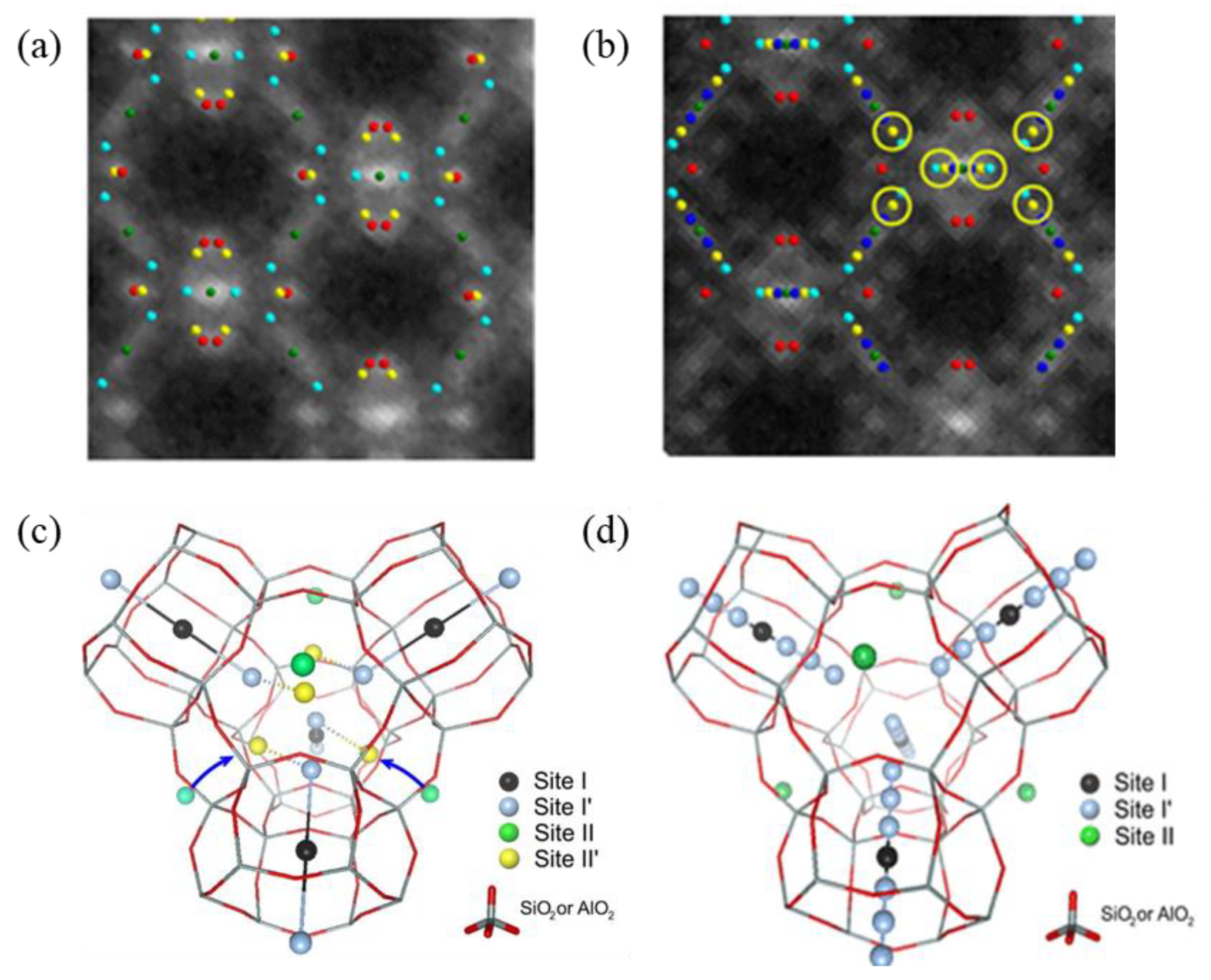
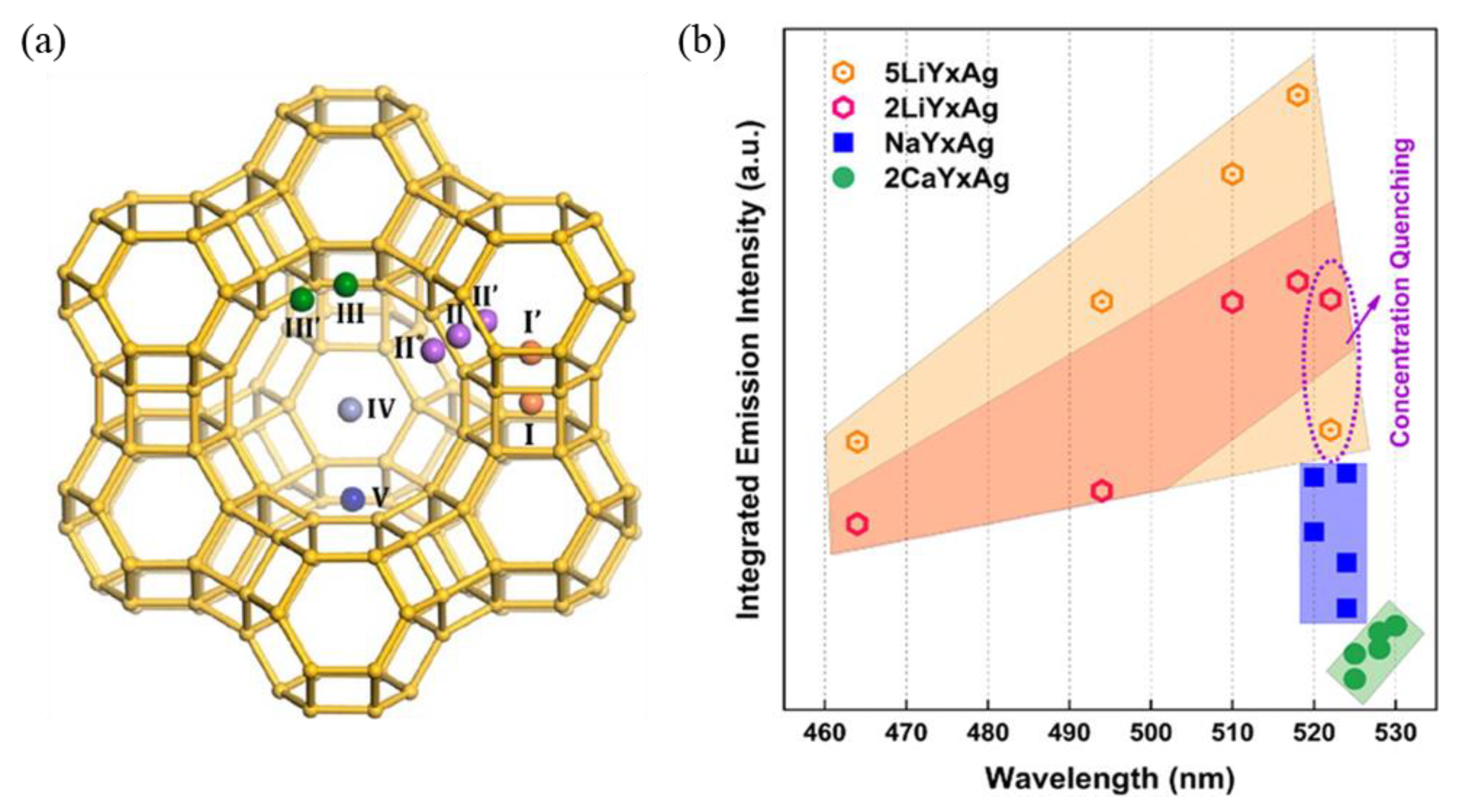
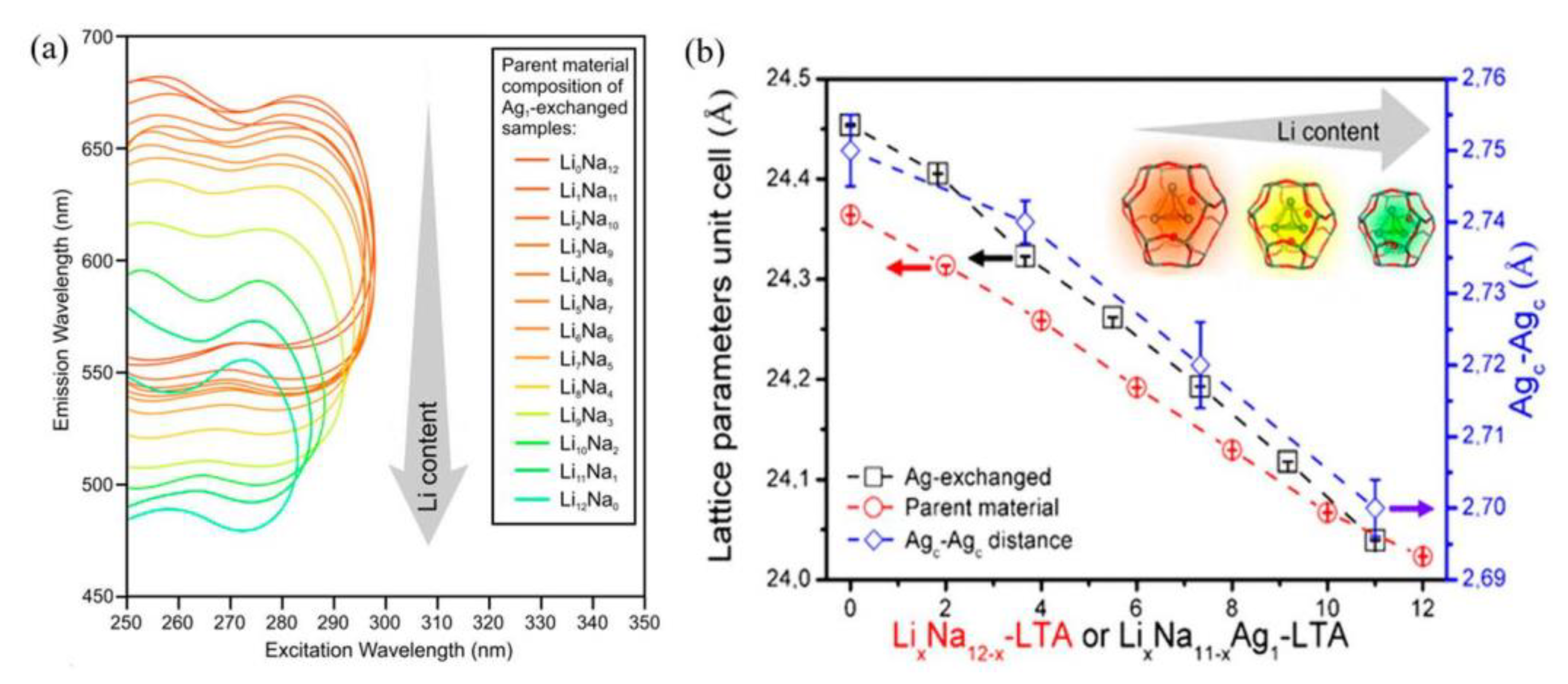
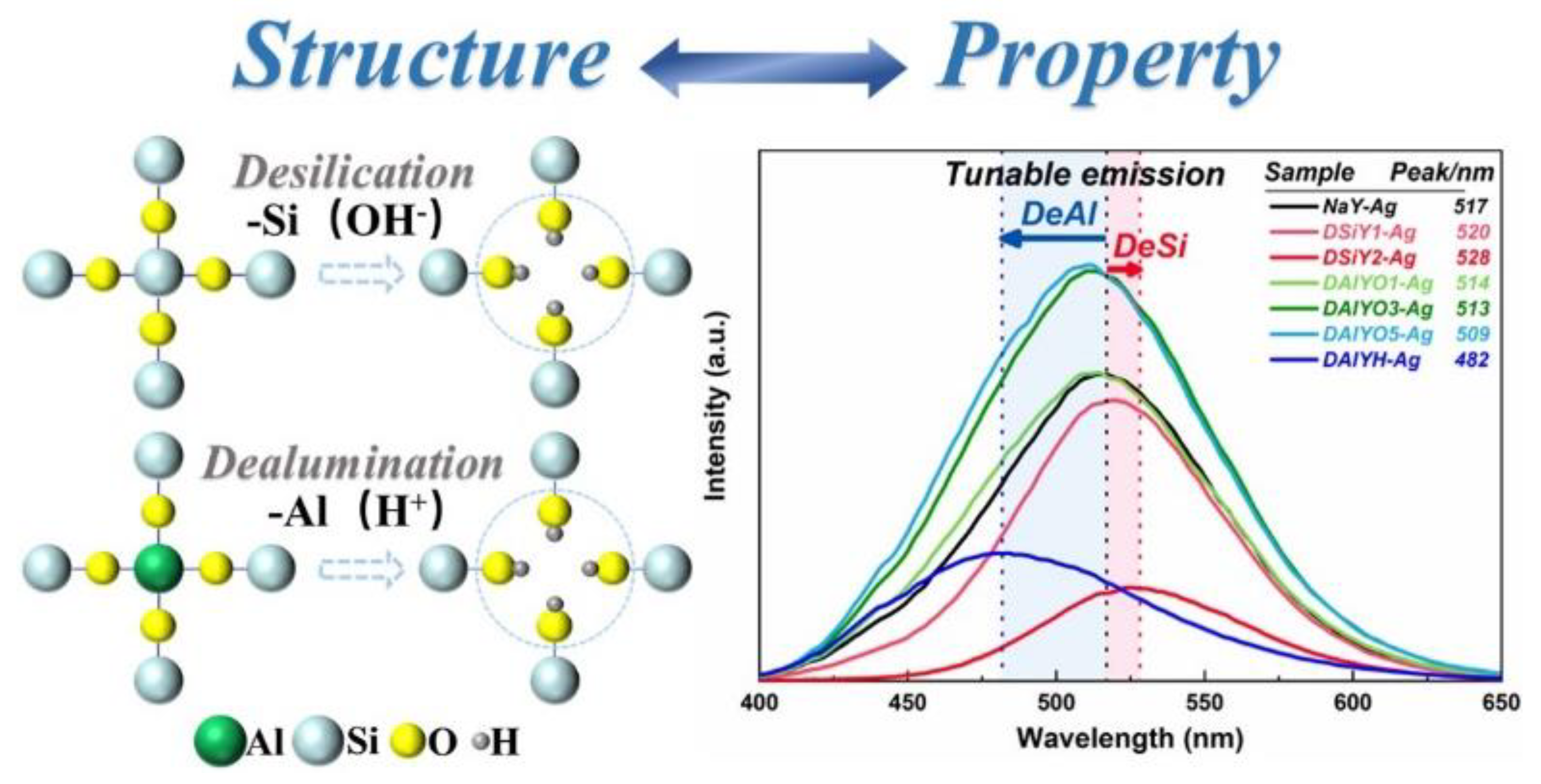
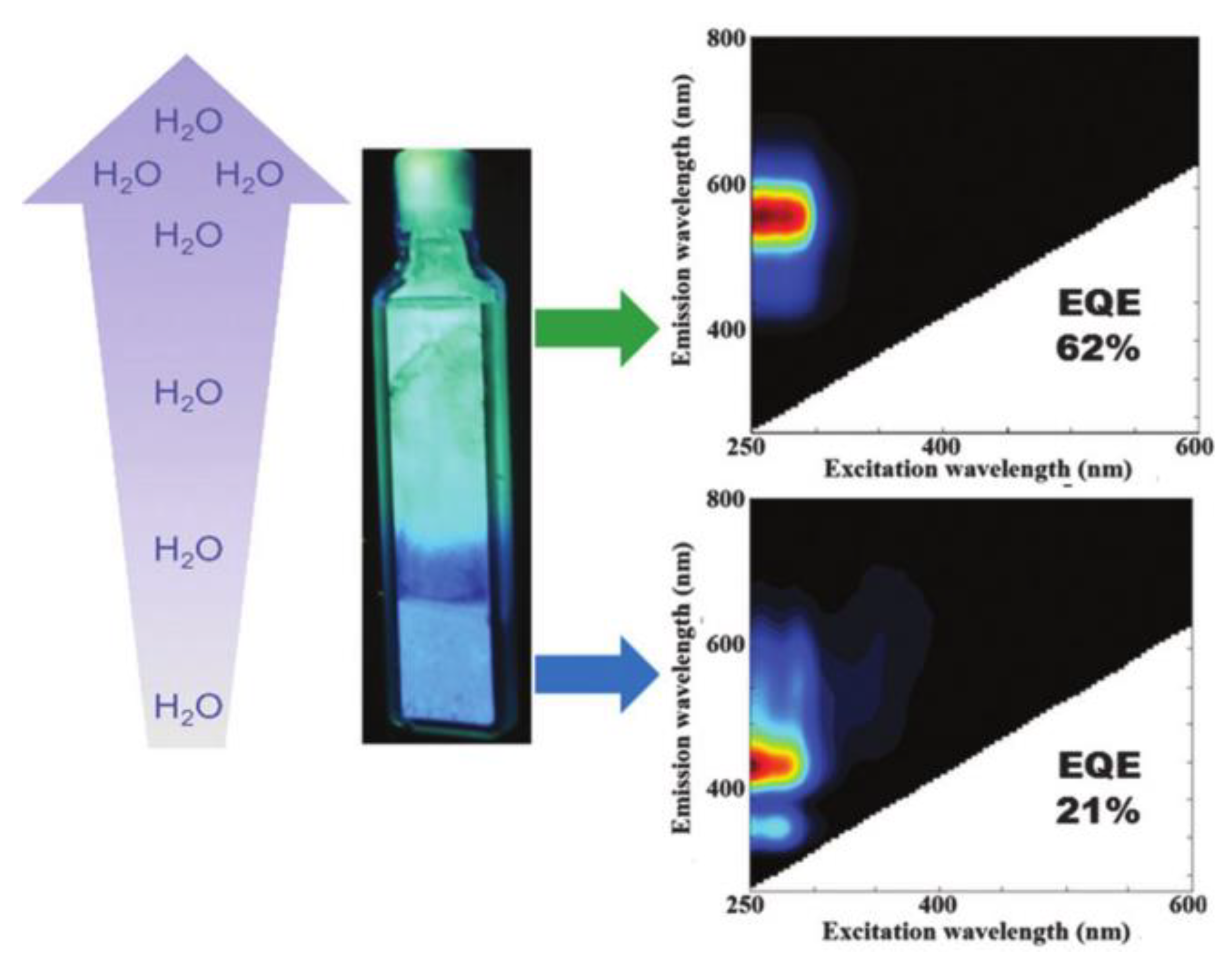

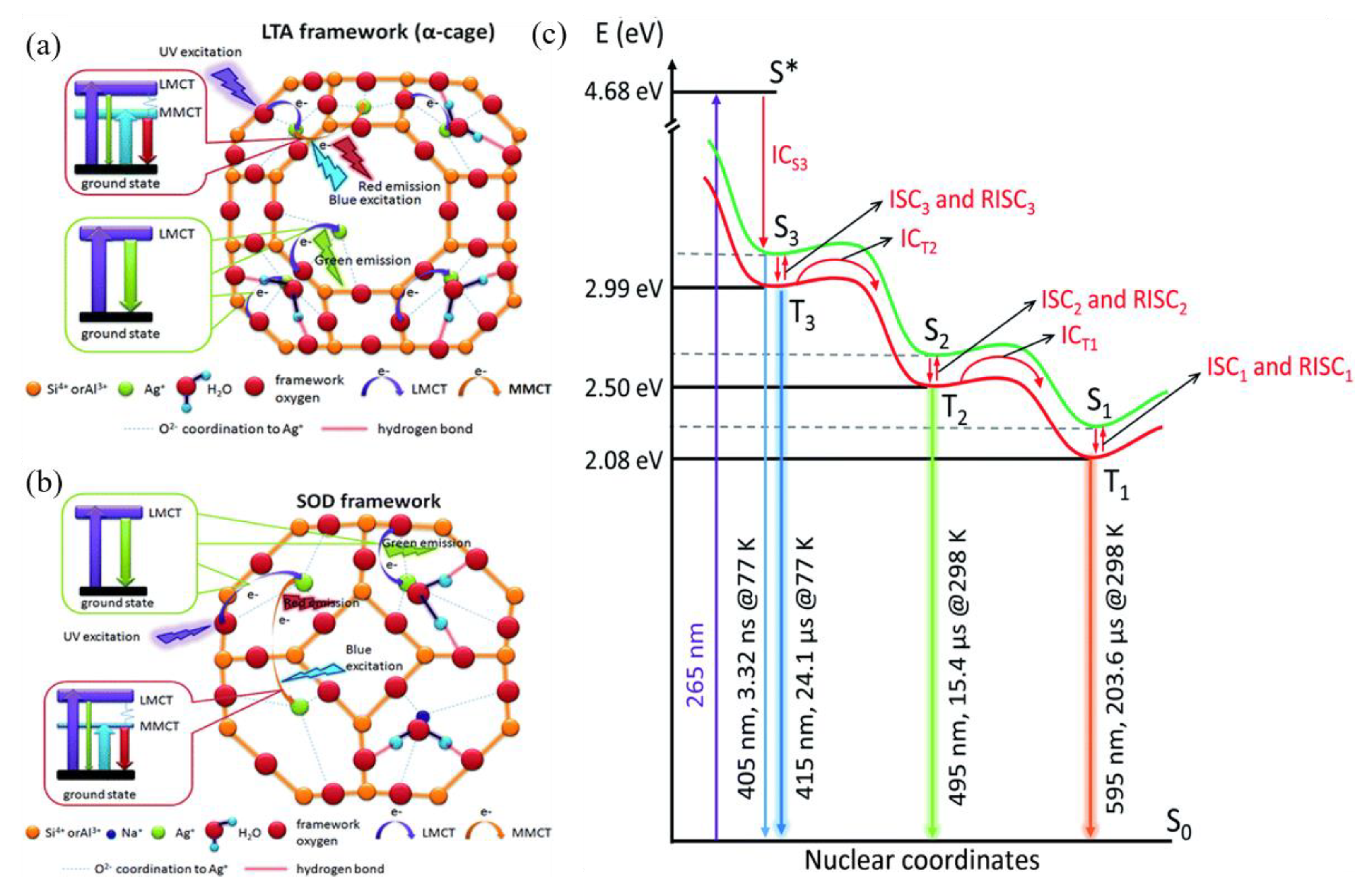
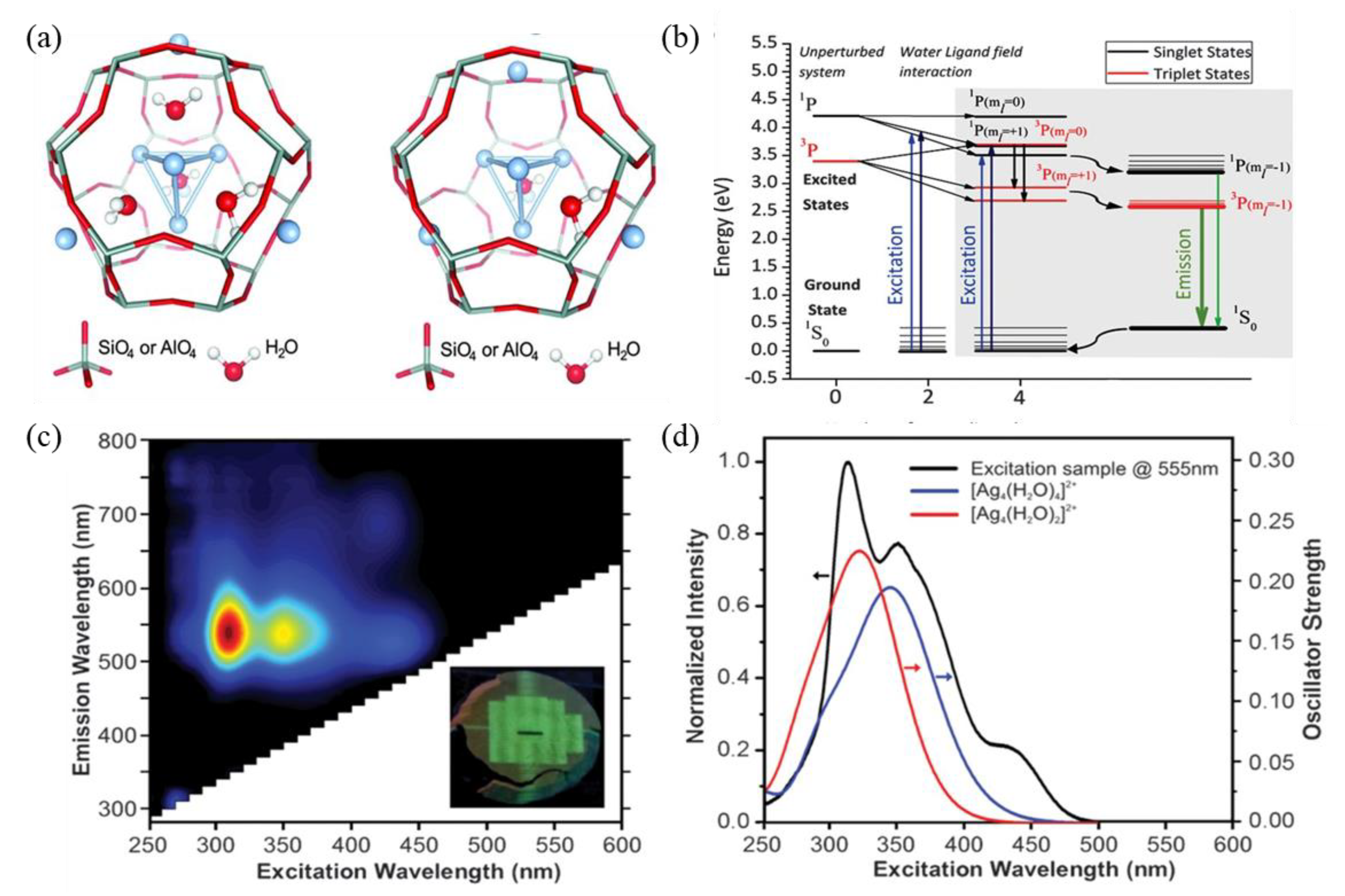

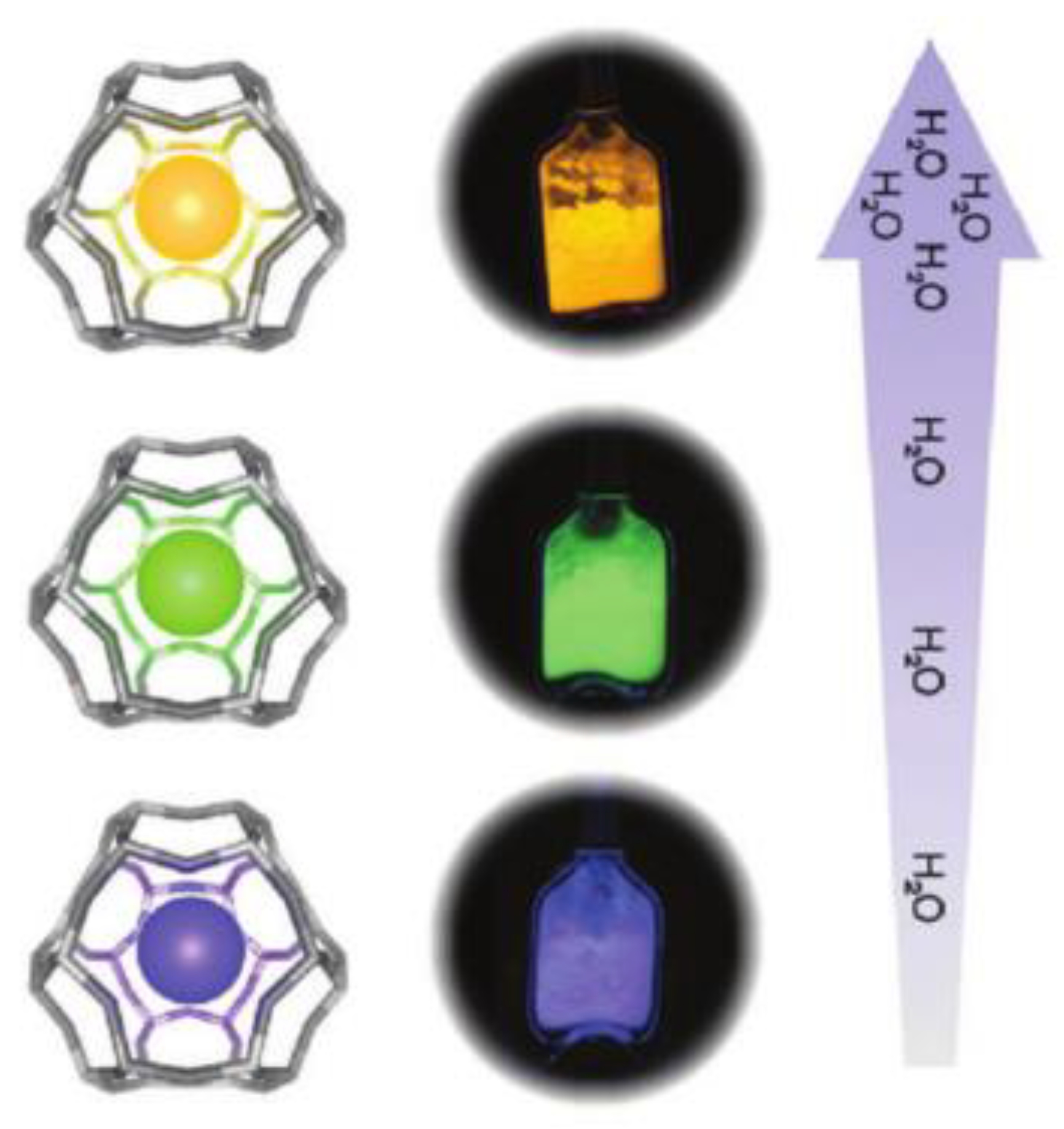

Disclaimer/Publisher’s Note: The statements, opinions and data contained in all publications are solely those of the individual author(s) and contributor(s) and not of MDPI and/or the editor(s). MDPI and/or the editor(s) disclaim responsibility for any injury to people or property resulting from any ideas, methods, instructions or products referred to in the content. |
© 2023 by the authors. Licensee MDPI, Basel, Switzerland. This article is an open access article distributed under the terms and conditions of the Creative Commons Attribution (CC BY) license (https://creativecommons.org/licenses/by/4.0/).
Share and Cite
Pan, L.; Ye, S.; Xv, X.; Lin, P.; Huang, R.; Wang, D. Zeolite-Encaged Luminescent Silver Nanoclusters. Materials 2023, 16, 3736. https://doi.org/10.3390/ma16103736
Pan L, Ye S, Xv X, Lin P, Huang R, Wang D. Zeolite-Encaged Luminescent Silver Nanoclusters. Materials. 2023; 16(10):3736. https://doi.org/10.3390/ma16103736
Chicago/Turabian StylePan, Ling, Song Ye, Xinling Xv, Peixuan Lin, Ruihao Huang, and Deping Wang. 2023. "Zeolite-Encaged Luminescent Silver Nanoclusters" Materials 16, no. 10: 3736. https://doi.org/10.3390/ma16103736
APA StylePan, L., Ye, S., Xv, X., Lin, P., Huang, R., & Wang, D. (2023). Zeolite-Encaged Luminescent Silver Nanoclusters. Materials, 16(10), 3736. https://doi.org/10.3390/ma16103736





